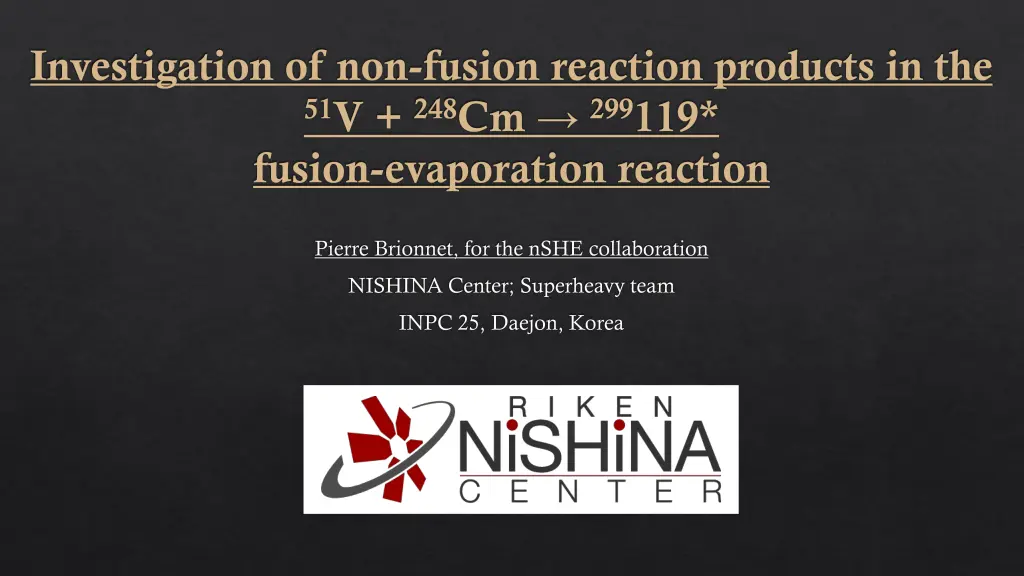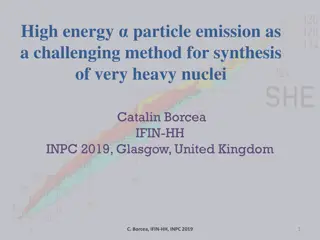
Investigation of Non-Fusion Reaction Products in 51V + 248Cm Fusion-Evaporation Reaction
Explore the ongoing experiment at RIKEN focusing on the search for Z=119 using the 51V + 248Cm fusion-evaporation reaction in the GARIS-III project. The importance of identifying and analyzing background events for accurate results is highlighted, along with insights into recoil analysis and production rate estimations.
Download Presentation

Please find below an Image/Link to download the presentation.
The content on the website is provided AS IS for your information and personal use only. It may not be sold, licensed, or shared on other websites without obtaining consent from the author. If you encounter any issues during the download, it is possible that the publisher has removed the file from their server.
You are allowed to download the files provided on this website for personal or commercial use, subject to the condition that they are used lawfully. All files are the property of their respective owners.
The content on the website is provided AS IS for your information and personal use only. It may not be sold, licensed, or shared on other websites without obtaining consent from the author.
E N D
Presentation Transcript
Investigation of non-fusion reaction products in the 51V + 248Cm 299119* fusion-evaporation reaction Pierre Brionnet, for the nSHE collaboration NISHINA Center; Superheavy team INPC 25, Daejon, Korea
Plan GARIS-III status and results Experimental setup @RIKEN Nishina Center Accelerator Detectors Electronics Experimental Results Reaction products identification Performance upgrades: Analog vs Digital DAQ Production Rates Comparison with similar studies at TASCA @GSI A. Di Nitto et al., Physics Letters B 784 (2018) 199 205
GARIS III ongoing experiment in RIKEN Search of Z = 119 currently on-going using the 51V + 248Cm 299119* fusion evaporation reaction. Optimization of the search conditions Noise level Detectors: DSSD and ToF First milestone reach : 5 fb cross section See K. Morimoto for a detailed overview (05/27) Search of Z = 119 : First two isotopes decay properties are not known for both 3n and 4n exit channels Need to find one decay chain with two unknown fast alphas Understanding the background events in the alpha spectrum is crucial for the rejection of false events Both slow and fast background characteristics are crucial
H. Sakai et al., Eur. Phys. J. A 58, 238 (2022). Experimental Setup Newly upgraded SRILAC Facility New ECR source and supra-conductive cavity GARIS-III separator and newly upgraded detector array Two Time of Flight detectors for the identification of the incoming ions 12 6 6 cm3Hamamatsu silicon detector box Dual DAQ: Analog and Digital Mesytech Analog electronics PIXIE-16 boards: 16 bits, 250 MHz D. Kaji Target Beam
Importance of this identification/analysis for Z = 119 experiment Understanding the background events in the alpha spectrum is crucial for the rejection of false events Both slow and fast background are overlapping the region of interest Background characteristics included in statistical analysis for the rejection of false event:
Recoil - 1- 2analysis: identification and production rate estimation Two main decay characteristics: E 1< E 2: strong indication of the nuclei being north-east of 208Pb Large amount of summed energy events (9 to 14 MeV) Fast decay around N = 128 - 132 Analog vs Digital electronics analysis: New Recoil - 1- 2true correlation (purple circle) Reduction of the summed energy signal (blue circle) 47 % of reduction of the background in the 10 to 14 MeV range (Dt < 500 ms) Production rate estimated based on this identification: 3 different methods used
Recoil - 1- 2analysis: identification and production rate estimation Decay time fitting from Recoil - 1- 2(220Ra ROI) Done for all defined ROI Cleanest measurements Not the full pictures N = 126 2not measured
Production rate estimation: Recoil - 1analysis Decay time fitting of the Recoil - 1correlation Access to N=126 - 127 Previously missing because not directly correlated Done for several energy slice: Long lived isotopes hard to access cleanly Underestimation due to summed energy with lower first-generation decay energies ( X ~ 27) Decay energy fitting of the Recoil - 1correlation Long-lived isotopes production rate Low production rate difficult to extract because of high background counts
Production rate estimation: Direct comparison Isotopic map: Similar to previous studies with a slightly larger distribution Production rate estimate from decay time fitting from the Recoil - 1- 2 matrix: 10 50 times lower than TASCA studies: Different optics? Dispersion?.. Mass spectrum could indicate an influence of N = 50 around Ni-Se region A. Di Nitto et al., Physics Letters B 784 (2018) 199 205
A. Di Nitto et al., Physics Letters B 784 (2018) 199205 Implantation/Energy profile Implantation profile and energy: big difference with the previous studies (TASCA) Energy: Two energy components expected based on the fission mechanism Only low recoil energy spectrum observe on GARIS-III Profile: Separator setup to 295-6119 : 2.17 Tm Expected B of these reaction products 1.6 Tm for LEC, 1.76 Tm for HEC Should be skewed toward low B side: skewed toward high B
Implantation/Energy profile Implantation profile and energy: big difference with the previous studies (TASCA) Low energy component only observed on GARIS III Implantation skewed toward high B side of the DSSD Indirect transport in GARIS III: Q2 : vertically focusing magnet: would affect LEC more due to lower velocity: off-axis transport TOF aperture would cut the off-axis transport D. Kaji Target Implantation profile stable throughout all Z = 119 experiment Beam Does not impact the success of Z = 119 search Only the production rate are used in the statistical analysis
Conclusion Search of new element Z = 119 reach important milestone and will continue onward Identification of the parasitic reaction products in the search of Z = 119 was performed Around north-east of 208Pb region around A = 217-220 Understanding of the rate and characteristic of the fast decay signal and parasitic 10-14 MeV alpha events Highlight the performance improvement of the digital electronics in the same condition Direct comparison to TASCA data with different reaction Similar identification Wider range of isotopes identified Different characteristics observed
Collaborator RIKEN Nishina Center : K. Morimoto, D. Kaji, H. Haba, H. Sakai Kyushu University: T. Niwase, S. Sakaghuchi, Y. Yamanouchi Oak Ridge National Laboratory (ORNL): T.T King, K. Rykaczewski University of Knoxville, TN: R. Grzywacz For the nSHE collaboration
Experimental condition Beam energy determined by Quasi-Elastic method M. Tanaka Journal of the Physical Society of Japan 91, 084201 (2022) Mid target energy of Elab= 283.09 MeV or E* = 40.3 MeV 2.85 m Ti Backing Cm2O3target: 400-500 g/cm2 Beam intensity: 1.5 p A average Duty cycle 85% Dose on this target: 3.63x1019
Reaction mechanism: MNT vs QF/FF Competion mechanisms in the fusion evaporation reaction: Mutli-Nucleon-Transfer reaction products around the target: 208Pb/209Bi or Actnides (248Cm for Z = 119) Quasi-Fission/Fusion-Fission Cold fusion reaction: Mostly MNT around N = 126 A. Nasirov et al., Eur. Phys. J. A (2013) 49: 147 Hot fusion reaction: QF/FF around A = 215-220 Identification performed based on genetic decay correlation : Recoil - 1- 2
Experimental Setup Fast Preamplifier: CREMAT Inc. CR.11X series Dual DAQ in parallel: Digital electronics: Pixie-16, 16 bits, 250 MHz, 16 channels boards Triggerless operation Reduction of the dead time Still in the deployement phase All detector channel digitized Mesytech Analog electronics P. Brionnet et al., NIM A Volume 1049, April 2023, 168068 Historic DAQ of the GARIS-II setup Global trigger: 2 trigger within 65 s Shaping dead time: 5 s after any event Both electronics used for the search
Correlation and Analysis Identification of the mechanism through the Recoil - 1 - 2genetic correlation Correlation done per pixel in the DSSD E 1< E 2: strong indication of the nuclei being north- east of 208Pb Too many nucleon to be MNT reaction QF/FF reaction products most likely Large amount of summed energy events (9 to 14 MeV) Fast decay around N = 128 - 132 Confirmed by energy/timming measurements Compared to NuDat3 for identification
Digital Electronics Analysis Fitting of the pile-up traces P. Brionnet et al., NIM A Volume 1049, April 2023, 168068 Custom fitting function developped Average 85 ns decay time As Fast as 55-60 ns Dead time remaining: 4 to 5 s: Trigger point (1 s)/ Trace length (5 s) 85 ns: Trigger shaping time for online pile-up detection
A. Di Nitto et al., Physics Letters B 784 (2018) 199205 Production rate estimation: Results/Comparison Isotopic map: Similar to previous studies: Slightly larger distribution Production rate estimation: Estimation of cross-section transmission (nb) TASCA : 50Ti + 249Cf for comparison Recoil alpha alpha Recoil alpha Time Recoil alpha Energy Z N126 127 128 129 130 131 132 133 134 135 136 137 138 Z N Z N 126 127 128 129 130 131 132 133 134 135 136 137 138 126 127 128 129 130 131 132 133 134 135 136 137 138 92 92 92 0 0 0 0 0 0 0 0 0 0 0 0 0 0 0 0 0 0 0 0 0 0 0 0 0 0 0 0 0 0 0 0 0 0 0 0 0 0 0 91 91 91 0 0 0 0 0 0 0 0 0 0.029 0 0 0 0 0 0 0 0 0 0 0 0 0 0 0 0 0 0 0 0 0.007 0 0 0.148 0.114 0 0 0 0 90 90 90 0 0 0 0 0 0.011 0.014 0.033 0.114 0.058 0.071 0 0 0 0.009 0 0 0 0.053 0 0.092 0.412 0.511 0 0 0 0.086 0.161 0 0 0 0.046 0.124 0.209 0.091 0 0 0 0 89 89 89 0 0 0 0.05 0.22 0.495 0.242 0.191 0.19 0 0 0 0 0 0 0 0 0 0.402 0.427 0.193 0 0.077 0 0 0 0 0.043 0 0 0.161 0.118 0.341 0.194 0.428 0.469 0 0 0 88 88 88 0 0 0 0.242 0.311 0.305 0.441 0.285 0.266 0.201 0.092 0 0 0.174 0.275 0 0 0.469 0.604 0.64 0.834 0.536 0 0 0 0 0.18 0.048 0 0.103 0.187 0.255 0.001 1.147 0.102 0 0 0 0 87 87 87 0 0 0 0.495 0.485 0.228 0.226 0.096 0.049 0 0 0 0 1.886 0.647 0 0 0 0.558 0 0 0.579 0 0 0 0 1.026 0.151 0 0.429 0.049 0.356 0.183 0 0.584 0 0 0 0 86 86 86 0 0 0 0.336 0.098 0.065 0.043 0.012 0.146 0 0 0 0 0 0.875 0 0.244 0.115 0.011 0 0 0.46 0 0 0 0 4.512 0.51 0 0.018 0.421 0.033 0 0 0.994 0.71 0 0 0 85 85 85 0 0 0 0 0.023 0 0 0 0 0 0 0 0 0 0.826 0 0.016 0.016 0.018 0.049 0 0.536 0 0 0 0 0 0.314 0 0.077 0 0 0 0.12 0 0 0 0 0 84 84 84 0 0 0 0 0 0 0 0 0 0 0 0 0 0 0.356 6.766 0 0.012 0.01 0.006 0 0 0 0 0 0 0 1.34 11.56 0.047 0.035 0.085 0 0.079 0 0 0 0 0 83 83 83 0 0 0 0 0 0 0 0 0 0 0 0 0 0 0 1.292 0.517 0 0 0 0 0 0 0 0 0 0 0 0 0 0 0 0 0 0 0 0 0 0 Digital Recoil - 1 : E 1 fit Digital Recoil - 1 - 2 Digital Recoil - 1 : Timming 82 82 82 0 0 0 0 0 0 0 0 0 0 0 0 0 0 0 0 0 0 0 0 0 0 0 0 0 0 0 0 0 0 0 0 0 0 0 0 0 0 0


